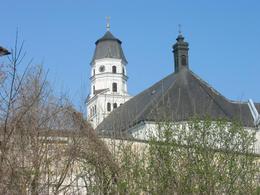Ehem. Franziskanerkloster Suben
Suben, Oberösterreich, Österreich
Suben Abbey is located on the east bank of the River Inn on a naturally protected headland formed by the Suben stream and the River Inn. There was probably a Celtic, pre-Germanic settlement here. Later there was a Roman fortification to protect the Inn navigation. In the 11th century, large parts of the area on the Lower Inn were owned by the Counts of Formbach (Vornbach), who built a castle with the church of St. Lambert in place of the Roman fortifications, similar to the neighbouring Vornbach. Around the middle of the 11th century, the two castles of Suben and Vornbach were converted into secular collegiate foundations by two daughters of Count Heinrich von Formbach and endowed with possessions and rights (Suben, for example, was granted the right of passage across the Inn to Schärding).
Suben was founded by Tuta, according to legend in fulfilment of a vow to save him from a water emergency on the Inn. Tuta was later probably married to a member of the Hungarian royal dynasty of the Arpads - according to tradition, she was even descended from the Hungarian royal family herself (according to the epitaph in the collegiate church, which incorrectly states 1136 as the year of her death). Tuta's foundation soon fell into decline again, however, until a son of Count Udalschalk von Formbach, the important ecclesiastical reformer Altmann (Bishop of Trento from 1124 to 1149), helped the monastery to establish a solid economic foundation: this was achieved through large donations in the Innviertel, Carinthia, Styria and the Wachau region.
Around 1144, Bishop Altmann gave the monastery to the Salzburg Cathedral Chapter for the establishment of an Augustinian canon monastery. The colonisation possibly took place from Aldersbach. Suben received important privileges from Salzburg and from the Bavarian and Babenberg dukes, e.g. toll (customs) freedoms, but its economic development remained insignificant because almost no parishes (Taufkirchen, Raab, Zell im Pramtal) were incorporated into the monastery.
Hardly anything is known about the internal development of the monastery, as most of the records have been lost. The period from the Thirty Years' War to the abolition was the heyday of Suben, mainly thanks to the personalities of the provosts. Provost Scharrer (1676 - 1696) was granted the right to use the pontificals by the Pope in 1684. His successor Gregor Raiffauer (1696 - 1720), the "Third Founder", had the neglected monastery buildings rebuilt. Under the provosts Ildefons Schalkhammer (1763 - 67) and Wilhelm Weber, the last provost (1767-84), the church was rebuilt and financed with funds from the agriculture and wine industry. On 6 March 1784, the abbey was dissolved by Emperor Joseph II and placed under the control of the neighbouring Reichersberg Abbey; in 1785, the collegiate church was designated a parish church, and in 1790 the vicar general of the newly founded diocese of Linz received the income.
In 1810, the Innviertel was temporarily returned to Bavaria. Napoleon awarded the abolished monasteries to deserving military leaders; General Prince Wrede received Suben. However, there was little interest in this property and it was therefore sold in 1854/56. The village was separated from the monastery as a political community, the 145 yards of monastery forest were auctioned off to farmers and the building was sold to the k.k. Penitentiary Fund. Initially, the Sisters of the Good Shepherd were in charge of the women's penal institution. Pastoral care was provided by the Franciscan order. In 1865, the sisters moved into the former Baumgartenberg convent and the state took over the management of the penal institution. On 13 August 1866, the institution was converted into a men's penal institution; in 1932 it was converted into a workhouse for men; in 1975 it was converted into a penal institution for men; it is currently run as a prison.
The parish church can be visited at any time during the day.
Suben was founded by Tuta, according to legend in fulfilment of a vow to save him from a water emergency on the Inn. Tuta was later probably married to a member of the Hungarian royal dynasty of the Arpads - according to tradition, she was even descended from the Hungarian royal family herself (according to the epitaph in the collegiate church, which incorrectly states 1136 as the year of her death). Tuta's foundation soon fell into decline again, however, until a son of Count Udalschalk von Formbach, the important ecclesiastical reformer Altmann (Bishop of Trento from 1124 to 1149), helped the monastery to establish a solid economic foundation: this was achieved through large donations in the Innviertel, Carinthia, Styria and the Wachau region.
Around 1144, Bishop Altmann gave the monastery to the Salzburg Cathedral Chapter for the establishment of an Augustinian canon monastery. The colonisation possibly took place from Aldersbach. Suben received important privileges from Salzburg and from the Bavarian and Babenberg dukes, e.g. toll (customs) freedoms, but its economic development remained insignificant because almost no parishes (Taufkirchen, Raab, Zell im Pramtal) were incorporated into the monastery.
Hardly anything is known about the internal development of the monastery, as most of the records have been lost. The period from the Thirty Years' War to the abolition was the heyday of Suben, mainly thanks to the personalities of the provosts. Provost Scharrer (1676 - 1696) was granted the right to use the pontificals by the Pope in 1684. His successor Gregor Raiffauer (1696 - 1720), the "Third Founder", had the neglected monastery buildings rebuilt. Under the provosts Ildefons Schalkhammer (1763 - 67) and Wilhelm Weber, the last provost (1767-84), the church was rebuilt and financed with funds from the agriculture and wine industry. On 6 March 1784, the abbey was dissolved by Emperor Joseph II and placed under the control of the neighbouring Reichersberg Abbey; in 1785, the collegiate church was designated a parish church, and in 1790 the vicar general of the newly founded diocese of Linz received the income.
In 1810, the Innviertel was temporarily returned to Bavaria. Napoleon awarded the abolished monasteries to deserving military leaders; General Prince Wrede received Suben. However, there was little interest in this property and it was therefore sold in 1854/56. The village was separated from the monastery as a political community, the 145 yards of monastery forest were auctioned off to farmers and the building was sold to the k.k. Penitentiary Fund. Initially, the Sisters of the Good Shepherd were in charge of the women's penal institution. Pastoral care was provided by the Franciscan order. In 1865, the sisters moved into the former Baumgartenberg convent and the state took over the management of the penal institution. On 13 August 1866, the institution was converted into a men's penal institution; in 1932 it was converted into a workhouse for men; in 1975 it was converted into a penal institution for men; it is currently run as a prison.
The parish church can be visited at any time during the day.
4975 Suben
Please get in touch for more information.



